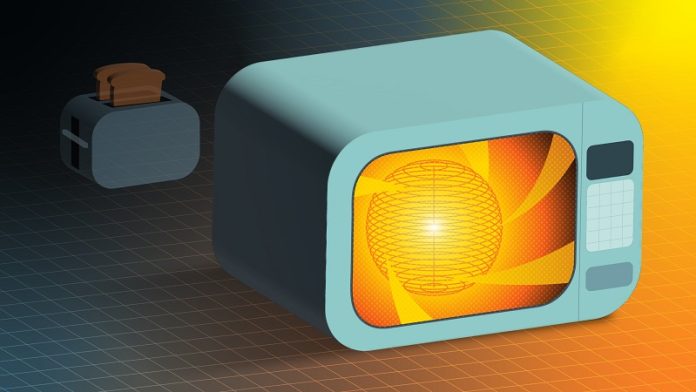
Scientists are exploring a new way to heat plasma for fusion energy using microwaves, potentially making fusion reactors smaller and more efficient.
This innovative method, proposed by researchers at the U.S. Department of Energy’s Princeton Plasma Physics Laboratory (PPPL), Tokamak Energy, and Kyushu University in Japan, aims to simplify fusion reactor design by eliminating a major heating component.
Fusion reactors, like spherical tokamaks, typically use a large copper coil called a solenoid to heat the plasma.
They also use neutral beam injection, where beams of uncharged particles are directed at the plasma.
However, these components take up a lot of space. Imagine trying to fit all your kitchen appliances into a tiny kitchen—it would be much easier with fewer appliances.
Similarly, a compact tokamak would be simpler and cheaper to build with fewer heating systems.
The new approach does away with ohmic heating, a method similar to how a toaster works and standard in many tokamaks.
“A compact, spherical tokamak plasma looks like a cored apple with a relatively small core, so one does not have the space for an ohmic heating coil,” said Masayuki Ono, a principal research physicist at PPPL and lead author of the study.
“If we don’t have to include an ohmic heating coil, we can probably design a machine that is easier and cheaper to build.”
This research, published in the journal Nuclear Fusion, explores the use of microwaves generated by a device called a gyrotron.
These gyrotrons would be positioned outside the tokamak, aiming powerful microwave beams into the plasma. This process, known as electron cyclotron current drive (ECCD), both heats the plasma and drives a current by moving negatively charged particles called electrons.
Using computer codes called TORAY and TRANSP, the team modeled different scenarios to find the best angles to aim the gyrotrons for maximum efficiency. The goal is to use as little power as possible to drive the necessary current. “Also, you have to try to avoid any of the power that you’re putting into the plasma coming back out,” explained Jack Berkery, a co-author and deputy director of research for the National Spherical Torus Experiment-Upgrade (NSTX-U). This can happen when the microwaves are reflected off the plasma or exit without affecting its current or temperature.
The researchers also determined which mode of ECCD works best at different stages of the heating process. There are two modes: ordinary mode (O mode) and extraordinary mode (X mode). X mode is better for ramping up the plasma’s temperature and current, while O mode is more efficient for maintaining high temperatures and densities once the plasma is heated.
The team also considered how impurities in the plasma could affect its performance. Elements with high atomic numbers, like tungsten and molybdenum, can cause significant heat loss if they enter the plasma.
“Even a relatively small amount of an element with a high Z number can cause the temperature of the plasma to cool significantly,” said Luis Delgado-Aparicio, the Lab’s head of the Advanced Projects Department and a co-author of the study. Keeping these impurities out of the plasma is crucial, especially during the initial heating phase.
This heating method is part of a larger project called the Spherical Tokamak Advanced Reactor (STAR), which aims to develop a pilot power plant. The project involves collaboration between PPPL and private companies like Tokamak Energy. Vladimir Shevchenko, a senior technical adviser at Tokamak Energy and co-author of the study, plans to run experiments in the company’s fusion vessel, ST40, to compare with the simulation results.
“Other heating systems have very, very serious problems,” Shevchenko said. “I see this as the future for tokamak heating systems.” He emphasized the value of the public-private partnership, stating, “PPPL has a lot of experienced specialists in different areas related to plasma physics and tokamak technologies. Their contribution in terms of modeling and advising is very valuable for a private company like Tokamak Energy.”
This new microwave heating method could revolutionize the design and efficiency of fusion reactors, bringing us closer to achieving sustainable fusion energy.



